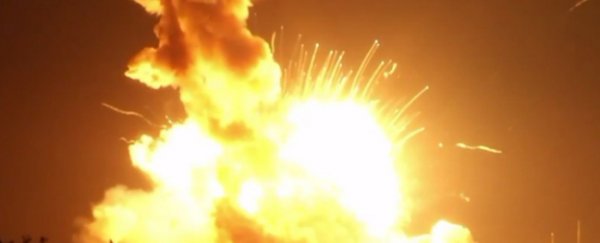Yesterday the Antares rocket exploded shortly after take off. Luckily no one was hurt, but there were some scientific casualties (RIP space worms).
The Orbital Sciences Corporation Antares rocket blasted off from Virginia in the US, yesterday, set to carry a range of supplies and experiments to the International Space Station (ISS). But just 15 seconds after launch the unmanned rocket exploded, and fell back onto the landing pad.
No one was hurt and the ISS has enough supplies to sustain its astronauts for almost six months, but sadly the rocket was carrying some pretty important scientific cargo.
"The greatest loss today has been the destruction of 18 student-led science projects into topics as diverse as how microgravity effects the growth of plants to milk spoiling in space," said astronomer Alan Duffy from Swinburne University of Technology.
"I'm absolutely heart-broken for these students who have put so many months work into this."
It's also a tough day for Orbital Sciences Corporation, one of the three commercial partners that NASA has contracted to deliver supplies to the ISS. This was their third resupply mission for NASA. Their spacecraft alone was worth $200 million, which the company has admitted it had "some" insurance on.
Fortunately, so far the damage to the Wallops flight facility, that the spacecraft was launched from, hasn't been too extensive. "This is great news for Orbital Science as this is the only facility rated to launch their Antares rockets from," said Duffy.
But it's not all bad news. Eric Holthaus from Slate spoke to science teacher Alison Ball, whose students had worms onboard Antares. Their project aimed to look into whether worms could compost food waste in microgravity (poor worms).
Inspiringly, she told Holthaus that there is still something to be learnt from the experience:
"Science can often be seen as this opportunity for really smart people to do work in a white coat in a really safe laboratory somewhere, and I think this gives the students a chance to get the idea that, really, science takes a lot of courage and it takes a lot of perseverance. It's about being able to find that determination to keep driving yourself forward in the face of failure."
Duffy agrees, and hopes that people will appreciate the difficult of space travel.
"We tend to think of routine resupply missions to the space station as a 'space taxi' but the fact is a rocket launch is a controlled explosion that you ride into orbit and is anything but mundane. Getting into space is hard," said Duffy. "Rocket science is rocket science after all."
"NASA takes safety seriously and this is a graphic example of why. The launch had even been postponed a day as a boat wandered into the exclusion zone East of the launch facility scrubbing the initial launch. I can imagine that captain is feeling very relieved today."
So what went wrong with the launch?
"It's too early to say what the cause is, but the sudden loss of thrust so soon after launch was the only visible problem after a seemingly textbook launch, but you can bet NASA will get to the bottom of it," said Duffy.
Although nothing is proved as yet, there's been speculation that there may have been fault in the Soviet rockets used in the spacecraft, which were originally developed in the '60s to power a rocket to go to the Moon. They stayed in storage for decades after the Soviets abandoned their efforts, until they were refurbished and incorporated into Antares. One of these engines failed during testing in May.
David W. Thompson, Orbital's chief executive, told the New York Times that we can expect to find out the cause of the explosion in weeks.
You can read the full interview with Alison Ball over at Slate.
Watch footage of the explosion below:

And the view from above:

Sources: Swinburne University of Technology, Slate, New York Times
